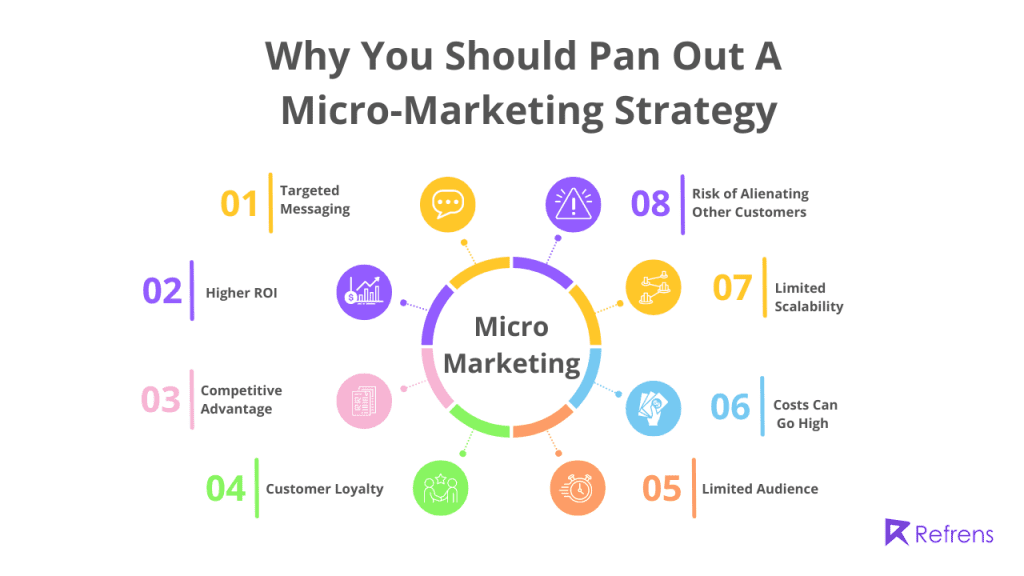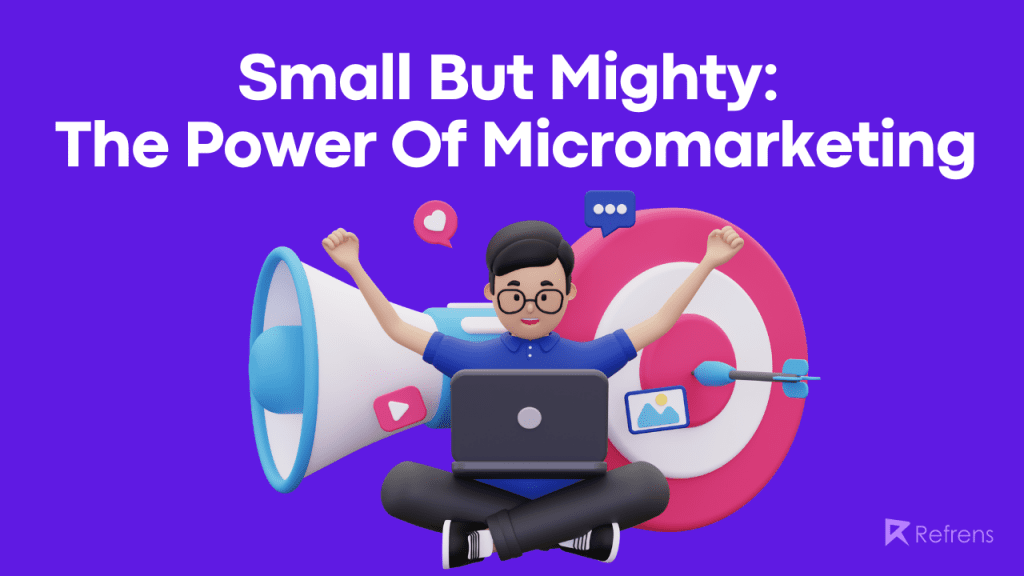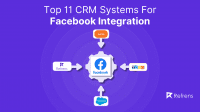“Marketing that actually works shouldn’t require a PhD in astrophysics! – according to Allen Gannett.
However, nowadays it feels like a cosmic challenge with newfangled tech, fickle customers, and diverse demographics. This forces companies to step up their game and experiment with fresh and funky approaches to snag customers’ interest.
Traditional marketing still has its place, but the game is changing. We’ve gone from spraying a wide net with mass marketing, to focusing on specific groups with segmented marketing, and now we’re getting even more up close and personal with macro and micro-marketing. What in the world are these, you ask? Let’s explore!”
What is Micro Marketing?
Micro-marketing is a strategy where companies target niche markets or specific individuals instead of a larger group of people. It is all about personalized and customized marketing efforts that focus on the needs and preferences of individual customers. It is also known as niche marketing!
This approach recognizes that not all customers have the same needs and preferences and that marketing efforts should be tailored to meet the unique needs of each customer. The goal of micro-marketing is often to identify a particular group of customers with specific needs and preferences and to create a product or service that caters to those needs.
This needs a deep understanding of the target audience, including demographics, psychographics, and behaviors. This approach allows businesses to create highly targeted marketing campaigns that are more likely to resonate with the target audience, leading to increased customer loyalty and higher leads and sales.
Micro-marketing can be particularly effective for small businesses, as it allows them to compete with larger companies by targeting specific niches where they can excel. For example, a small business that sells organic baby products might create a micro-marketing campaign that targets new parents who are environmentally conscious and health-conscious. The campaign might include personalized messaging that highlights the benefits of using organic baby products.
But, how does it work? How does it ensure every customer’s need is considered in marketing? Let’s find out!
How Micro-Marketing Works?
Micro-marketing can be complex. But, not if businesses comprehend the goal!
It works primarily by collecting data about customers’ preferences, behavior, and interests through various channels. These can be social media, website analytics, and customer feedback. This data is then analyzed to identify patterns and insights that help businesses to create more personalized and customized marketing campaigns.
Check out the top tools for social media in 2023.
For instance, a business can use data analytics to track customers’ online behaviors, such as the products they view, the pages they visit, and the ads they click on. This information can be used to create more personalized ads that target the interests and preferences of specific customers.
This helps businesses provide personalized recommendations that can assist in building stronger relationships with their customers, increase customer loyalty, and ultimately drive sales. So, by adding visual elements and personalization, companies can create interactive marketing campaigns, engage, and maintain good relationships with customers.
But, does this convince you to build micro-marketing strategies for your business right now? We doubt it!
Here’s Why You Should Pan Out A Micro- Marketing Strategy

Micromarketing can be of great advantage for businesses of all scales. Be it small businesses just gathering traction or is it a medium or large-sized business looking to boost sales and revenue? Here are some of the reasons why-
1. Targeted Messaging
Whatever marketing strategy you implement for your business, the message it delivers is important. And, that’s where micro-marketing can be of help!
Micro-marketing allows businesses to craft highly targeted messaging that resonates with their target audience. It can help them deliver exactly what they want. This helps businesses create a brand voice and leave an impression on the audience!
2. Higher ROI
Micro-marketing can be a cost-effective approach since it focuses on a specific audience with a highly tailored message. As a result, businesses can achieve a higher return on investment (ROI) compared to broad-based marketing campaigns.
This strategy also helps to increase the relevance and effectiveness of marketing campaigns, resulting in higher engagement and conversion rates.
3. Competitive Advantage
By targeting a specific niche, businesses can differentiate themselves from competitors and create a unique value proposition. This assists businesses to stand out in a crowded market and establish themselves as a leader in their niche. Just because they delivered and propagated their brand message precisely with micro-marketing!
4. Customer Loyalty
Have you ever thought about why your customers keep on losing trust in your business? This is one of the strenuous challenges for businesses. But, micro marketing can mitigate this risk!
When businesses target a specific audience, they can build deeper relationships with customers by offering highly personalized products and services. This approach can gain businesses loyal customers and increase customer retention rates, resulting in long-term business success.
But, is the grass always green?
No marketing strategy works always (Thanks to dynamic markets and unpredictable customer behavior). This takes us to discuss why micro-marketing might not be the right strategy for your business-
5. Limited Audience
One of the biggest drawbacks of micro-marketing is that it limits the potential audience for a business. So, if you are a business looking to expand your reach and service area, this approach may not be suitable for you!
6. Costs Can Go High!
While micro-marketing can be a cost-effective marketing approach, it can also be expensive to implement. This approach requires businesses to invest in highly targeted marketing campaigns, which can be costly and time-consuming.
7. Limited Scalability
As the name suggests, niche marketing, Micro-marketing is a highly targeted approach. This limits its significance for larger businesses. As a business grows, it may need to broaden its marketing strategy to reach a larger audience.
8. Risk of Alienating Other Customers
By targeting a specific audience through micro-marketing, businesses run the risk of alienating other potential customers who may not fall within their target audience. This approach may result in missed opportunities to attract new customers and expand the customer base.
But, all these drawbacks only harm you if you don’t implement your micro-marketing strategy precisely. So, how to ensure you leverage it correctly and most profitably?
Steps To Help A Freelancer, Agency, or Small Business To Implement Micro-Marketing?
We know designing a micro-marketing strategy that provides maximum returns can push you off the rails. That’s why we have assembled these tips and tricks for you to do it the right way next time!
1. Define Your Target Audience
The first step in implementing micro-marketing is to define your target audience. After all, what good is marketing if it does not target a specific customer? And, micro-marketing is all about niche-based marketing!
For this, identify the specific demographic or group of customers that you want to reach. This could be based on your product or service. The deciding factors can be the age, gender, income, location, or interests of your customer. Is your product or service ideally for youth? Or does it target people who have low incomes? Carefully analyze these factors to identify your target audience. This can help you create marketing messages that are tailored to their specific needs and interests.
To enhance your strategy, consider partnering with a fractional CMO. Their expertise in identifying target audiences and crafting effective marketing strategies can ensure your micro-marketing campaigns align with customer needs and preferences. This collaboration can lead to increased customer engagement and business growth.
2. Utilize Social Media
Not leveraging social media for your business in this modern era can make your business vanish in thin air. Therefore, social media is said to be an effective tool for micro-marketing.
Check out the social media strategies for freelancers.
To gain maximum advantage from social media, identify the social media platforms that your target audience uses. Increase your business’s presence on these platforms possibly with help from growth hacking agencies, and create content that speaks directly to them. This could include blog posts, images, videos, or social media posts that showcase your products or services. Use social media analytics to track engagement and adjust your content accordingly.
Check out the 3 ways through which you can boost your social media business.
3. Create Personalized Content
Designing a strategy for your target audience is the sole goal of micro-marketing! And, once you have identified your target audience, creating personalized content that speaks directly to their needs and interests is an ideal approach.
For this, use social media analytics tools!
Know where they respond best. What resonates with them more? This could be social media polls, blog posts, social media updates, or email newsletters. Use language and tone that makes your audience feel welcomed and heard. Along with this, highlight the benefits of your product or service. Tailor your micro-marketing for them, not for your business!
4. Use Targeted Advertising
Targeted advertising is a way to reach a small, and specific audience. And, micro marketing also focuses on tools that provide targeted marketing.
This can include using platforms such as Facebook Ads or Google AdWords to create ads that are targeted to your ideal customer. This could include factors such as location, interests, or behaviors. Use keywords that your users might be searching for you. Also, use analytics to track the performance of your ads and act accordingly. To maximize benefits, businesses can also consider audience segmentation to send targeted messages based on factors such as purchase history or demographics.
5. Partner With Influencers
Everyone appreciates the effect and benefits of influencer marketing these days. And, why wouldn’t they? It provides attention from related customers and also provides the limelight every business craves for! And, not only for businesses, if you are freelancer, partnering with the right influencers can become your strength.
Shoutouts, sponsored posts, and collaboration can be the ways to leverage this. But, to make sure you get it done right, identify influencers who are relevant to your industry and work with them to create content that showcases your products or services. Use software analytics to track engagement and adjust your influencer marketing strategy accordingly.
These were the tips for you to excel in your micro-marketing campaign. But, hold on! If you’re a small business or a freelancer looking to gather traction or attention from your customers, you might have also come across a strategy known as macro-marketing!
Enough With The Micro, What’s Macro-Marketing?
Macro-marketing (different from micro-marketing) is a marketing approach that focuses on the overall market and the economy as a whole. This approach is less concerned with the specific needs and preferences of individual customers and more focused on broader economic and societal trends. Macro-marketing typically involves using data and analytics to identify larger market trends and create marketing campaigns that appeal to a wide range of customers.
For example, a macro-marketing campaign for a consumer electronics company might focus on the overall trend toward digital connectivity and the need for products that allow customers to stay connected on the go. The campaign might use broad messaging that appeals to a wide range of customers, and it might use mass media channels like television and radio to reach a large audience.
But, if you are a small business or a newbie, or an experienced freelancer, micro marketing sounds like a better approach for you! How? Did it work before for businesses? It sure did!
Real-Life Successes of Micro-Marketing
Coca-Cola’s “Share a Coke” Campaign
Can you think of a large business leveraging micro-marketing? Well, Coca-cola aced this right!
Coca-Cola’s “Share a Coke” campaign is a prime example of a successful micro-marketing campaign. The campaign involved printing popular names on Coca-Cola bottles and cans and encouraging customers to share a Coke with someone whose name was on the bottle or can.
The campaign was highly appreciated as it allowed customers to find bottles and cans with their names or the names of their loved ones on them. This made the brand reach millions with just a micro initiative!
Spotify’s “Year in Review” Campaign
Spotify’s “Year in Review” campaign is another successful example of micro-marketing. The campaign involved creating personalized playlists for each Spotify user that highlighted their most played songs and artists from the past year.
The campaign was highly personalized and made a significant number of music enthusiasts sign up and share their playlists through Spotify!
All these examples tell us how niche marketing or tailoring your marketing campaigns to specific audiences can help you gain benefits. So, are you ready to do something like this to maximize the benefits of marketing campaigns?
Summary
Micro-marketing is a powerful tool that can benefit small businesses and freelancers alike. In particular, it offers a unique advantage for freelancers who want to promote their services without coming across as overly aggressive or pushy to potential customers who may not be interested in their offerings.
The key to successful micro-marketing is to identify your target audience and develop tailored strategies that will resonate with them. By honing in on the specific needs, interests, and pain points of your ideal customer, you can create marketing campaigns that are more personalized, effective, and engaging.
One of the greatest advantages of micro-marketing for freelancers is that it allows them to focus their efforts on the customers who are most likely to be interested in their services. By understanding their customers’ preferences, behaviors, and motivations, freelancers can tailor their marketing messages to attract and retain those who are most likely to benefit from their services.
Moreover, micro-marketing strategies tend to be more cost-effective than traditional mass marketing approaches. By targeting a specific audience with customized content and messaging, freelancers can maximize their marketing budgets and get a better return on investment.

















